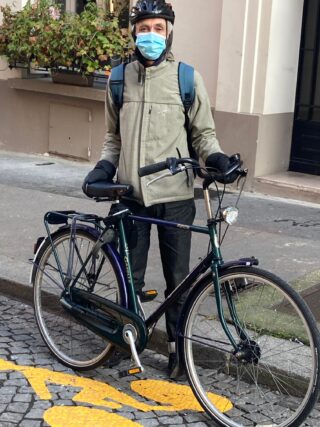Cycling News & Blog Articles
My Paris Commute: A video diary from a BikePortlander abroad
— Reader Robert D’s view of riding to work on the streets of Paris was put into words by Lisa Caballero. Robert shot the raw video from his bike and it was edited by Jonathan Maus.
I relocated to Paris from Portland last November for a six-month work stint. I’ve commuted to work by bike for most of my 20 years in Portland, so I was eager to give daily commuting in Paris a try.

Hi, I’m Robert. I’m smiling under my mask.
I won’t keep you in suspense—I was good at dodge-ball as a kid, so let’s just say that my Paris commute is exhilarating. But that is not the reason why I am writing this piece, or why I made a video of my commute. Rather, I think Paris has some lessons for Portland, the most important being that big improvements for cyclists can happen quickly—but they require boldness, vision and assertive leadership.
My commute begins on a “coronapiste” or “corona track,” one of over 50 kilometers (30 miles) of temporary protected bicycle lanes the city built in response to the pandemic. This particular coronapiste is on the Rue de Vaugirard which, at 2.7 miles, is the longest road in Paris. As I ride along, notice that the city has dedicated about 25 to 40% of the street cross-section to the bike lane—this on a major city street! The coronapistes were rapidly built with plastic bollards and small jersey barriers, recently Mayor Anne Hidalgo announced that the city would make them permanent.
Advertisement
paris-map
My commute
By removing car lanes, however, the traffic now moves more slowly. The presence of protected bike lanes not only gives people a safer place to ride, it has a traffic-calming effect.
From there I ride for a while in the bus lane on the Rue de Rennes (cyclists are allowed to use bus lanes). The next segment shows me on a “Shared Street.” I arrive at the Seine in the fourth segment, and ride on a section of the “express cycling network,” or REVe which was built as part of Plan Velo, the 2015-2020 bicycle plan. The REVe provides a north-south and east-west spine to the bicycle network, and also runs along the Seine.
Finally, in the last segment, I approach and traverse the rotary around the Place de la Bastille.
As you can see in the video, riding in Paris is pretty intense, you have to anticipate how a dense and varied group of street participants is going to act. It can be chaotic. Given that, it might be surprising to a Portlander how many women and older people ride bicycles here, and also parents with children on board, and children themselves. There are a couple of factors which help make the streets feel safer to everyone.
The first is speed. I’ve visited Paris regularly since the 1970s and I remember driving here and being uncomfortable as my fellow drivers tore down cobblestone streets at about 40 mph. It was hair-raising and I wouldn’t have dared to get on a bicycle. Like most cities at the time, Paris was given over to cars. By removing car lanes, however, the traffic now moves more slowly. The presence of protected bike lanes not only gives people a safer place to ride, it has a traffic-calming effect.
Advertisement
The second is attitude. I’ve yet to be yelled at by a driver in Paris. There is just less tension and hostility on the street. The number of people on bikes has reached a critical mass that makes riding feel safer (you are not alone, you are often in a crowd) and drivers know to look for other road users. There is not the “what are you doing on my road” attitude. It also helps that the cars are smaller. Despite being hectic, riding feels safer here.
I’ve yet to be yelled at by a driver in Paris. There is just less tension and hostility on the street.
Portland is not Paris, the six- to seven-story contiguous buildings which line every street here speak of a density which Portland does not have, and which allows for a mature transit network. But Paris is also not Amsterdam, which has had good bicycle infrastructure for decades. Rather, Paris teaches that a city can quickly transform itself from being dominated by cars to being a place that is safe, and pleasurable, for people to walk and bike. Paris might help Portlanders imagine how that can be; the speed at which this city changed is in itself inspiring.
How did it happen? In the spirit of never letting a good crisis go to waste, Paris leveraged the pandemic to overcome mode-change inertia. Plan Velo was already in place, but the general strike of December 2019 (which included transit workers) followed by the pandemic, let the city seize an opportunity to aggressively expand its bicycle network. As a result, Paris has seen 47% increase in the use of bike lanes, and nearly half of today’s cyclists are new to biking in the city.
Mayor Hidalgo has closely associated herself with this transportation revolution. With Plan Velo II (2021-2026), she plans to add another 80 miles of protected bike lanes with the goal of making 100% of Paris’s streets safely cyclable. In Paris, active transportation has active and energetic leadership. And that is the lesson, bike infrastructure doesn’t just happen, it requires visionary leaders who seize every opportunity for transformation. Paris shows what is possible.
![]()
Lisa Caballero has lived in SW Portland for 20 years. She is on the Transportation Committee of her neighborhood association, the Southwest Hills Residential League (SWHRL) and can be reached at This email address is being protected from spambots. You need JavaScript enabled to view it..

